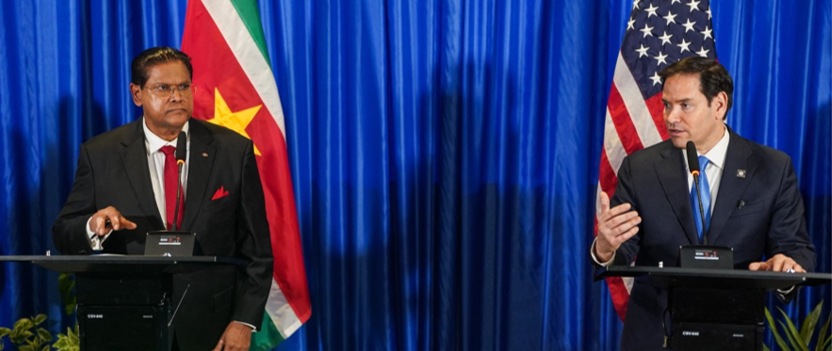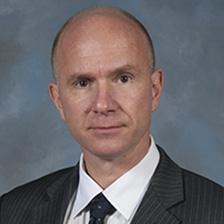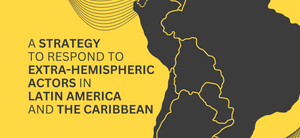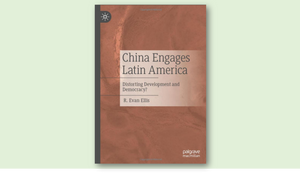
Why Suriname Matters: South America’s Overlooked Strategic Geography
Introduction
Secretary of State Marco Rubio’s April 2025 visit to Suriname highlighted the importance of the often overlooked country on the northeast coast of South America, whose former Foreign Minister, Alberto Ramdin, was elected secretary general of the Organization of American States (OAS) in March 2025.
On May 25, Suriname will hold its first national elections since its electoral rules were restructured by an October 2023 law and constitutional amendment. Seven or more parties could win seats in the national parliament in the country’s new one-district, proportional representation electoral system. This could include roughly equal but minority representation for both of Suriname’s largest rival parties, the Progressive Reform Party (VHP) of the current President Chan Santokhi, and the more left-oriented National Democratic Party (NDP) of the country’s recently deceased former president and military dictator, Dési Bouterse.
The outcome of the likely negotiations to form a government between the parties of a fragmented Surinamese National Assembly following the May 25 election is highly uncertain, but has significant implications for the country, the region, and the United States. Suriname, which receives almost no attention in the U.S. media, is an important emerging petroleum producer and source of strategic minerals, including gold and bauxite; a stronghold of Chinese commercial, cultural, and political presence; a transit country for Europe-bound cocaine; and a hub of illegal mining with a scarcely populated, little controlled, 90 percent jungle-covered interior.
Suriname is a country in which natural resource wealth, cultural diversity, political complexity, corruption, and danger form a tapestry of contradictions. In this physically large country of only 647,000 people, in March 2015, Dino Bouterse, the son of the country’s former dictator, Dési Bouterse, was convicted in a U.S. court for contracting with whom he believed were Hezbollah affiliates to set up a terrorist training camp.
Understanding Suriname’s Electoral System
Suriname’s new electoral system arises from an August 2022 decision by the nation’s supreme court. The former system featured a system of ten proportional representation districts of vastly different population sizes and was deemed unconstitutional because it did not give equivalent representation to all Surinamese. The Surinamese Defense Force had encouraged the adoption of the former system in the transition from military rule with the adoption of the 1987 constitution, so that the residents of the sparsely populated interior of the country would feel represented and thus connected to the nation. These groups, relatively isolated from the government in Paramaribo, had given rise to a significant informal economy, criminal activity, and even an insurgent group, the Surinamese Liberation Army.
The new system, established in October 2023 by the previously noted adaptation of a new electoral law and constitutional amendment, made the entire country a single proportional representation district in which the number of seats in the assembly won by each party now corresponds to their percentage of the vote nationally. The change is expected to hurt parties with strong affiliations with particular ethnic groups that previously won seats through a strong presence in sparsely populated communities. Conversely, the new system is expected to bolster the performance of parties with a more diffuse appeal across the nation, even if a small one.
Such possible impacts are politically salient in Suriname because the country’s politics are shaped by the complex, sometimes conflictual relationships between a tapestry of ethnic groups, principally those of Indian, African (“maroons”), Javanese, Chinese, and European (predominantly Dutch) origin.
Most of the key parties in Suriname are dominated by particular ethnic groups. Indo-Surinamese disproportionately identify with the Progressive Reform Party (VHP) of President Santokhi. Afro-Surinamese ethnic political representation is split among several parties with subethnic differences. These include the Surinam National Party (NPS), the General Liberation and Development Party (ABOP) of maroon leader and former rebel Ronnie Brunswijk, and the Brotherhood and Unity in Politics (BEP) party. The Pendawa Lima, or “Five Sons of King Pandu” party (PL), although promoting multiethnic inclusiveness, in fact disproportionately attracts Surinamese of Javanese origin.
Other key parties in Suriname have a more complex, although still ethnically skewed, following. These include the long-dominant National Democratic Party (NDP) with a generally leftist nationalist orientation. It is not clear how the December 2024 death of NDP founder longtime leader, Dési Bouterse, will affect the party’s dynamics and direction.
Suriname’s Upcoming Elections
In the context of the previously discussed challenges facing the nation, the outcome of the May 25 election under the new system will thus indirectly, but importantly, shape how Suriname’s ethnic groups perceive their share of power and access to resources within the new system.
Little public polling has been done in Suriname, and 14 parties are officially registered on the ballot. Although tentative, one analysis of party strength manifested in the previous election in 2020, adjusted by the possible impact of electoral changes and issues affecting the country, suggests that the outcome will be a greater fragmentation of seats, albeit with continuity of the relative number of seats of the strongest parties. The study suggests that the NDP could win 16 seats in the 51-seat National Assembly, the VHP taking 14, the ABOP 8, the NPS 7, the PL 2, and the BEP 2, with the other two distributed across the other parties.
If something close to this outcome occurs, whether the next government coalition is dominated by the relatively U.S.-friendly VHP, the leftist nationalist NDP, or some other possibility will thus depend on a combination of the shift of just a few seats and the complex negotiations between parties that the results will set into motion.
Further complicating matters, fights among the parties in the current governing coalition suggest that even if the distribution of seats in parliament comes out similar to what it is now, the governing coalition may not hold. Specifically, when Interior Minister Bronto Somohardio was forced to resign in October 2024 over allegations of wrongdoing, it unleashed a fight between governing coalition partners PL and the ABOP, who have significantly more seats, over who would replace Somohardio. President Santokhi ultimately named the ABOP candidate Delano Landvreugd to the post, leaving the PL feeling sidelined as they contemplate participation in any post–May 2025 VHP-led government.
Suriname’s Post-Election Opportunities and Challenges
Suriname’s election outcome will be consequential for the country, the region, and the United States in a variety of domains.
In economic matters, like neighboring Guyana, Suriname is moving to develop its oil resources, which could be transformative for the country. The country may have as much as 30 billion barrels of recoverable oil despite a population of only 647,000. The largest current oilfield, Block 58, under development by TotalEnergies, is expected to begin producing in 2028. Suriname’s eventual oil output could reach between 200,000–500,000 barrels per day. Moreover, the national oil company Staatsolie has not yet contracted out 60 percent of the blocks where oil could be found, but is currently pursuing an ambitious plan to do so.
Beyond oil, Suriname’s new government will also be impactful on the trajectory of the country’s relationship with the People’s Republic of China (PRC), whose position there is deeply rooted, significant, and growing.
PRC-based businesses began substantially expanding in Suriname in 1998 with the signing of a memorandum of understanding by then-President Jules Wijdenbosch during a state visit to the PRC. That agreement opened the door for the entry of China Dailan into the country to perform substantial road and other infrastructure projects. The entry of Chinese workers into the country for such projects facilitated a significant expansion of the already deeply rooted Chinese community there.
The PRC’s presence in Suriname expanded significantly during the Presidency of Dési Bouterse (2010–2020), with at least $776 million in loan-based projects. During this period, China’s Huawei also made significant inroads in the telecommunication infrastructure in the country. Meanwhile, in the logging sector, China Greenhart acquired direct and indirect control over significant amounts of timberland in the country’s interior.
In April 2018, Suriname became one of the first Latin American governments to join the PRC Belt and Road Initiative, and in 2019, it was recognized by the PRC as a “strategic cooperative partner” of the PRC.
Under the current President Chan Santokhi, who visited the PRC in April 2024, China’s position in Suriname’s petroleum and mining sectors expanded significantly. Notable advances included Iamgold’s 2022 selloff of its Surinamese mining assets to China’s Zijin for $360 million, a 2024 award by Staatsolie for Petrochina to develop Blocks 14 and 15 of Suriname’s petroleum reserves, and a $426 million investment by China Aluminum Corporation for a bauxite mine the same year.
Even while the PRC continued to win new business and investment under the Santokhi government, Suriname also entered into arrears on part of the $476 million in debt still owed to the PRC for previous infrastructure work contracted to Chinese companies, principally under Dési Bouterse. Suriname and China ultimately reached an agreement in November 2024 to restructure, yet still fully pay that debt. Those negotiations by China contrasted with the behavior of Suriname’s other creditors owed a total of $2.7 billion and collectively bargained through the “Paris Club” to write down part of what Suriname owed, as well as others who agreed to exchange Surinamese government bonds at a loss in November 2023.
Beyond the economy and China, whoever forms the next Surinamese government will be challenged to address its deepening role as a regional criminal hub. The country, with its difficult-to-control interior region and borders, has increasingly been used as a transit zone for cocaine and other drugs being shipped from Colombia and Venezuela to Europe. Reflecting its role in drug transits to Europe, the Italian criminal organization Ndrangheta was discovered operating in the country in 2018. Use of the Port of Paramaribo by drug traffickers has been a problem, although not the only use of Surinamese territory by drug traffickers. In 2015, authorities discovered the construction of narcosubmarines in the river area near the coast. Smuggling through the Parimaribo-Zanderij International Airport has also been a problem. Indeed, customs authorities at the airport did not even have drug scanners until November 2023.
Beyond narcotrafficking, the interior of Suriname has long been the site of significant illegal mining activity, particularly gold mining. This illicit activity includes a significant number of non-Surinamese miners, including those from Brazil and Russia. It also involves other illicit businesses that accompany illicit mining, such as prostitution. Trafficking in timber and wildlife in the interior is also a problem.
Although rates of homicide and other violent crime in Suriname have historically been low, in 2024, homicides increased by 382 percent over the previous year to 29.9/100,000, while violent crime with guns increased 123 percent, reflecting the substantial illicit economy, but also other socioeconomic problems.
Beyond such issues, other key questions for the next government will be management of corruption, managing debt and economic reform, and working with the United States.
Suriname ranks in the middle of the pack on Corruption. Its score of 40/100 on the Transparency International Corruption Perception Index ranks it 88th of 180 countries globally. Sixteen countries in Latin America are better, and sixteen countries are worse than Suriname. Accusations of corruption have been leveled against the Suriname Postal Bank, the electricity company EBS, and Surinam Airways, among others. Symbolically, former President Dési Bouterse was sentenced in December 2023 for murder, but never served in prison before his death in December 2024.
With respect to the economy, despite the promise of the country’s new oil wealth, richness in minerals, timber, and other resources, and an expected 3 percent growth in 2025, the country’s economic trajectory is fraught with perils. Public debt is an onerous 79 percent of GDP. To maintain the highly indebted country’s liquidity, the Santokhi government negotiated an Extended Fund Facility (EFF) from the International Monetary Fund. The ninth review under that EFF in March 2025 came out positive, freeing up the disbursement of an additional $62 million of funds. Still, the economic reforms implemented by the Santokhi government to restore the economy to health and financial stability, including the elimination of electricity, fuel, and water subsidies, have been painful for Surinamese and politically costly for Santokhi’s VHP government, creating the risk that the next government could be tempted to return to the self-destructive populism of the Bouterse era, particularly as Suriname’s new oil wealth comes online.
Suriname’s Path Forward with the United States
Finally, Suriname’s new government will face difficult, yet important choices in navigating its relationship with the U.S. Secretary of State Marco Rubio, during the press conference following his meeting with President Santokhi, noted that for Suriname to be a friend, partner, or ally, “there are benefits for that.”
The more petroleum-friendly posture of the Trump administration creates opportunities for expanded participation by U.S.-based companies. President Santokhi welcomed the prospect for such engagement during his April 2025 meeting with Secretary Rubio, referring to the upcoming Surinamese Energy, Oil, and Gas Summit and Exhibition in Paramaribo.
On the other hand, in the fight against criminality, the future of expanded U.S.-Suriname counternarcotics cooperation, including the possible reopening of a U.S. Drug and Enforcement Administration office in Paramaribo, or expanded cooperation with the U.S. Coast Guard for drug interceptions in Surinamese waters, such as the “shiprider program,” are less clear.
Beyond specific opportunities for cooperation, there is a risk that a proud, less U.S-friendly future Surinamese government, buoyed by the election of experienced Surinamese diplomat Alberto Ramdin as head of the OAS and by new oil revenues, and offended by the perceived heavy-handed U.S. approach to the region, could make common cause with more left-oriented governments in an emerging push-back against the United States. Such pushback could naturally be accompanied by deepening cooperation with the PRC and other geopolitical rivals.
The path that often-overlooked Suriname will chart in the weeks ahead is uncertain, but it is important for U.S. policymakers not to leave it off the map.
Evan Ellis is a senior associate (non-resident) with the Americas Program at the Center for Strategic and International Studies in Washington, D.C.



